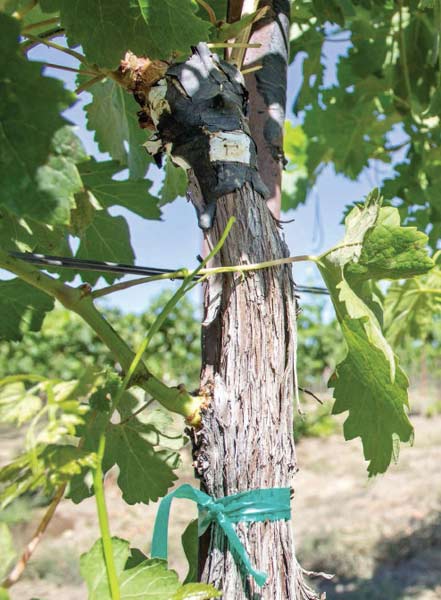
John Gomez of Hedges Family Estates talks about field grafting in the winery’s Red Mountain vineyard near Benton City, Washington, in August. Gomez shared his experience with grafting Cabernet Sauvignon onto Merlot plants during a Washington State University Viticulture and Enology Field Day. (Shannon Dininny/Good Fruit Grower)
When Hedges Family Estates wanted additional acreage planted in Cabernet Sauvignon to meet rising demand, the longtime wine grape growers and vintners on Washington’s famed Red
Mountain had a few options.
One: Pull out a 25-year-old block of Merlot, drip irrigated and planted to 10-foot-by-4-foot spacing. They could have replanted in 8-by-4-foot spacing, which would equate to more plants and a few more tons of fruit.
But the cost of starting a Cabernet Sauvignon block from bare ground, which meant pulling out everything and reinstalling a new trellis system, was about $18,000 per acre.
“Our accountant said, ‘Find a better solution,’” Vineyard Manager John Gomez said. Option two: Spend about $6,500 per acre just to get everything clean, rather than remove the entire system, and replant. “The accountant said, ‘Find something else,’” Gomez said.
The best benefit, money-wise, and the option they chose: Cleaning up materials, cutting back the plants and grafting on Cabernet Sauvignon, at a cost of $2,800 per acre.
“The plants being 20-plus years old, we thought if we could get another 10 years out of them, maybe then we could come in and replant,” Gomez said at a Washington State University Viticulture and Enology Field day in August at the vineyard outside of Benton City, Washington. “We always pick this Merlot block right around Labor Day, no matter whether it’s a cold or hot year. That’s the reason we chose it — it’s a consistent block. The thought was to take the best of the Cab and the Merlot to start again.”
More and more, wine grape growers are turning to grafting new varieties onto existing vines in hopes of saving money and producing fruit more quickly.

Black tape marks the graft union of Cabernet Sauvignon onto Merlot plants at a Hedges Family Estates vineyard. The shoot on the lower left may still be Merlot because it’s below the union, Gomez said, and crews will have to go through next spring to eliminate those shoots. (Shannon Dininny/Good Fruit Grower)
“You’re definitely into production quicker versus starting over entirely,” said Kevin Judkins, nursery manager of Inland Desert Nursery. “A lot of that goes back to recouping revenue sooner. You have a trellis system that’s already there and setup in place. As long as the spacing is desirable and the rootstock is clean, it’s a good option.”
The drawback — and the risk, especially in the early years — is an early fall cold snap that takes out young grafts.
“If it’s still green at the graft union and we get a cold front, it can cause a lot of damage,” he said. “It’s like starting all over again.”
Most of the grafting in Washington has been of red varieties to white varieties, particularly in some young Riesling blocks, since that variety has fallen slightly in popularity.
However, Judkins warned growers to be wary of leafroll virus, which is symptomless in white varieties.
“You graft reds on top and it lights up. You have to be cautious of that and maybe consider testing the rootstock
before grafting,” he said.
Judkis often has growers come to the nursery looking to buy certified budwood to graft onto their existing vineyards.
However, Hedges Family Estates chose to take cuttings from its best Cab block. Inland Nursery picked the cuttings at dormancy, usually a six-bud cutting reduced to two-bud spurs grafted onto each vine in the spring.
Gomez hired a crew from California to handle the grafting. “If we’d had half an acre, maybe 1 acre, we might have done this ourselves,” he said. “I wasn’t going to screw up 6 acres.”
– by Shannon Dininny






Leave A Comment